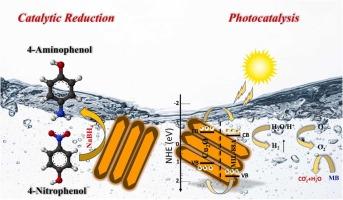In-Situ Growing of MIL88A(Fe)@Active Faceted Cu2O Core-Shell Heterostructure for Super Photocatalytic Performance and Catalytic Reduction of Toxic Nitrophenol Compounds
IF 5.8
2区 材料科学
Q2 CHEMISTRY, PHYSICAL
引用次数: 0
Abstract
Herein, well-constructed 2D active (110) and (111) faceted Cu2O nanosheets are in-situ grown on the surface of spindle MIL-88A to form a novel porous MIL88A (Fe)@active faceted Cu2O core-shell heterostructure via a facile solvothermal method. The fabricated heterostructure is optimized to be a promising catalyst for the catalytic reduction of various nitrophenol compounds such as P-nitrophenol and 2,4-dinitrophenols, as well as the removal of methylene blue dye (MB). The optimal M88@Cu2O-2 heterostructure demonstrated an outstanding catalytic performance for reducing nitrophenols, reaching 96.7% for P-nitrophenol and 96.1% for 2.4-dinitrophenol. It also achieved excellent photocatalytic activity for MB dye, reaching 95% through 30 min, compared to 64% and 72% for Cu2O and MIL-88A, with rate constants (k) reaching 0.1, 0.038, and 0.04 min-1, respectively. The surprising photocatalytic performance of the prepared structure could be attributed to the following aspects: (i) the growth of the active (111) and (110) facets Cu2O on the surface of MIL-88A, which could provide various surface energies, reactivates, and crystallographic arrangements, all of which impact the photocatalytic efficiency of the designed M88@Cu2O-2 heterostructure, (ii) the construction of an efficient heterojunction between active faceted Cu2O and MIL88A, which resists the recombination of e- and h+, improving the migration and separation of charge carriers, and (iii) the core-shell construction could provide more electron transport channels to significantly enhance the suppression of electron-hole pair recombination in the photocatalytic process. Besides that, the M88@Cu2O-2 core-shell has great photo-electrochemical performance, reaching 17.68 μA/cm2 for the photocurrent test and 73 mA/cm2 for the LSV test when exposed to visible light. Our study will provide a new vision for developing more hierarchical core/shell MOF-based heterostructures with outstanding multifunctional performance for future industrial practice.

原位生长 MIL88A(Fe)@活性面状 Cu2O 核壳异质结构以获得超级光催化性能并催化还原有毒的硝基苯酚化合物
本文通过简便的溶热法,在主轴 MIL-88A 表面原位生长了结构良好的二维活性(110)和(111)刻面 Cu2O 纳米片,形成了新型多孔 MIL88A (Fe)@ 活性刻面 Cu2O 核壳异质结构。经过优化,制备的异质结构有望成为催化还原各种硝基苯酚化合物(如对硝基苯酚和 2,4-二硝基苯酚)以及去除亚甲基蓝染料(MB)的催化剂。最佳的 M88@Cu2O-2 异质结构在还原硝基苯酚方面表现出卓越的催化性能,对硝基苯酚的还原率达到 96.7%,对 2.4-二硝基苯酚的还原率达到 96.1%。它对 MB 染料的光催化活性也非常出色,在 30 分钟内达到 95%,而 Cu2O 和 MIL-88A 分别为 64% 和 72%,速率常数(k)分别为 0.1、0.038 和 0.04 min-1。所制备结构令人惊讶的光催化性能可归因于以下几个方面:(i) 在 MIL-88A 表面生长了活性(111)和(110)面 Cu2O,这可以提供不同的表面能、再活化物和晶体学排列,所有这些都会影响所设计的 M88@Cu2O-2 异质结构的光催化效率;(ii) 在活性面 Cu2O 和 MIL88A 之间构建了高效的异质结、(iii) 核壳结构可提供更多的电子传输通道,从而显著增强光催化过程中对电子-空穴对重组的抑制作用。此外,M88@Cu2O-2 核壳还具有良好的光电化学性能,在可见光下的光电流测试和 LSV 测试分别达到 17.68 μA/cm2 和 73 mA/cm2。我们的研究将为开发更多具有优异多功能性能的基于MOF的分层核/壳异质结构提供新的视角,为未来的工业实践服务。
本文章由计算机程序翻译,如有差异,请以英文原文为准。
求助全文
约1分钟内获得全文
求助全文
来源期刊

Journal of Alloys and Compounds
工程技术-材料科学:综合
CiteScore
11.10
自引率
14.50%
发文量
5146
审稿时长
67 days
期刊介绍:
The Journal of Alloys and Compounds is intended to serve as an international medium for the publication of work on solid materials comprising compounds as well as alloys. Its great strength lies in the diversity of discipline which it encompasses, drawing together results from materials science, solid-state chemistry and physics.
 求助内容:
求助内容: 应助结果提醒方式:
应助结果提醒方式:


